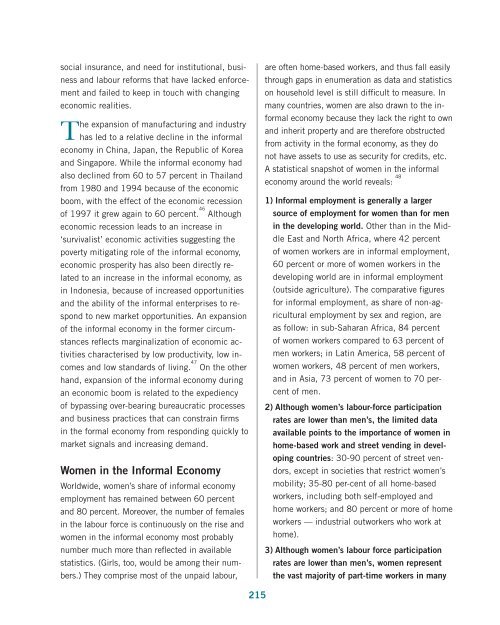Download the file - United Nations Rule of Law
Download the file - United Nations Rule of Law
Download the file - United Nations Rule of Law
Create successful ePaper yourself
Turn your PDF publications into a flip-book with our unique Google optimized e-Paper software.
social insurance, and need for institutional, businessand labour reforms that have lacked enforcementand failed to keep in touch with changingeconomic realities.The expansion <strong>of</strong> manufacturing and industryhas led to a relative decline in <strong>the</strong> informaleconomy in China, Japan, <strong>the</strong> Republic <strong>of</strong> Koreaand Singapore. While <strong>the</strong> informal economy hadalso declined from 60 to 57 percent in Thailandfrom 1980 and 1994 because <strong>of</strong> <strong>the</strong> economicboom, with <strong>the</strong> effect <strong>of</strong> <strong>the</strong> economic recession<strong>of</strong> 1997 it grew again to 60 percent. 46 Althougheconomic recession leads to an increase in‘survivalist’ economic activities suggesting <strong>the</strong>poverty mitigating role <strong>of</strong> <strong>the</strong> informal economy,economic prosperity has also been directly relatedto an increase in <strong>the</strong> informal economy, asin Indonesia, because <strong>of</strong> increased opportunitiesand <strong>the</strong> ability <strong>of</strong> <strong>the</strong> informal enterprises to respondto new market opportunities. An expansion<strong>of</strong> <strong>the</strong> informal economy in <strong>the</strong> former circumstancesreflects marginalization <strong>of</strong> economic activitiescharacterised by low productivity, low incomesand low standards <strong>of</strong> living. 47 On <strong>the</strong> o<strong>the</strong>rhand, expansion <strong>of</strong> <strong>the</strong> informal economy duringan economic boom is related to <strong>the</strong> expediency<strong>of</strong> bypassing over-bearing bureaucratic processesand business practices that can constrain firmsin <strong>the</strong> formal economy from responding quickly tomarket signals and increasing demand.Women in <strong>the</strong> Informal EconomyWorldwide, women’s share <strong>of</strong> informal economyemployment has remained between 60 percentand 80 percent. Moreover, <strong>the</strong> number <strong>of</strong> femalesin <strong>the</strong> labour force is continuously on <strong>the</strong> rise andwomen in <strong>the</strong> informal economy most probablynumber much more than reflected in availablestatistics. (Girls, too, would be among <strong>the</strong>ir numbers.)They comprise most <strong>of</strong> <strong>the</strong> unpaid labour,are <strong>of</strong>ten home-based workers, and thus fall easilythrough gaps in enumeration as data and statisticson household level is still difficult to measure. Inmany countries, women are also drawn to <strong>the</strong> informaleconomy because <strong>the</strong>y lack <strong>the</strong> right to ownand inherit property and are <strong>the</strong>refore obstructedfrom activity in <strong>the</strong> formal economy, as <strong>the</strong>y donot have assets to use as security for credits, etc.A statistical snapshot <strong>of</strong> women in <strong>the</strong> informaleconomy around <strong>the</strong> world reveals: 481) Informal employment is generally a largersource <strong>of</strong> employment for women than for menin <strong>the</strong> developing world. O<strong>the</strong>r than in <strong>the</strong> MiddleEast and North Africa, where 42 percent<strong>of</strong> women workers are in informal employment,60 percent or more <strong>of</strong> women workers in <strong>the</strong>developing world are in informal employment(outside agriculture). The comparative figuresfor informal employment, as share <strong>of</strong> non-agriculturalemployment by sex and region, areas follow: in sub-Saharan Africa, 84 percent<strong>of</strong> women workers compared to 63 percent <strong>of</strong>men workers; in Latin America, 58 percent <strong>of</strong>women workers, 48 percent <strong>of</strong> men workers,and in Asia, 73 percent <strong>of</strong> women to 70 percent<strong>of</strong> men.2) Although women’s labour-force participationrates are lower than men’s, <strong>the</strong> limited dataavailable points to <strong>the</strong> importance <strong>of</strong> women inhome-based work and street vending in developingcountries: 30-90 percent <strong>of</strong> street vendors,except in societies that restrict women’smobility; 35-80 per-cent <strong>of</strong> all home-basedworkers, including both self-employed andhome workers; and 80 percent or more <strong>of</strong> homeworkers — industrial outworkers who work athome).3) Although women’s labour force participationrates are lower than men’s, women represent<strong>the</strong> vast majority <strong>of</strong> part-time workers in many215
















